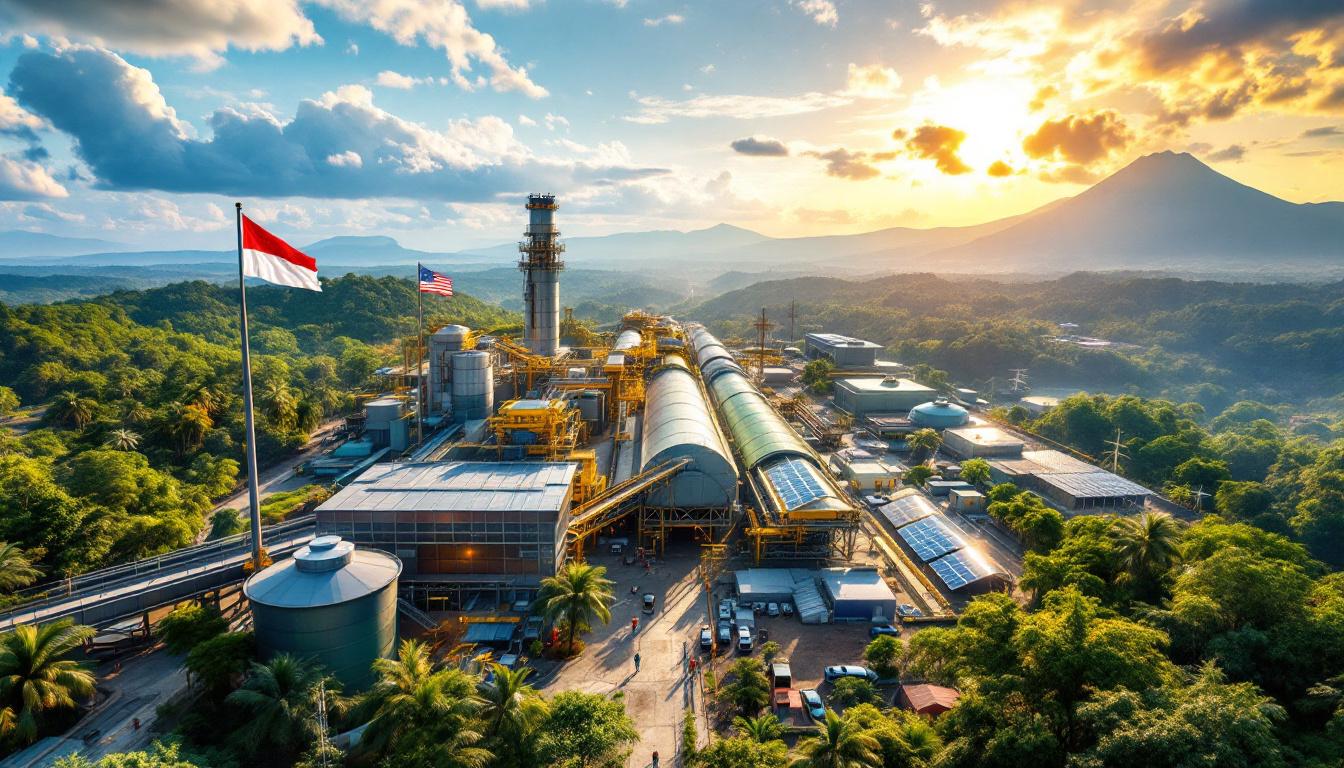South Africa's New Policy for the Ferrochrome Industry: Chrome Ore Export Controls and Electricity Incentives
South Africa's Cabinet has officially approved a comprehensive policy package aimed at revitalizing the country's declining ferrochrome industry. This strategic intervention includes chrome ore export controls and electricity incentive policies designed to stabilize and stimulate growth in the local ferrochrome sector. The decision follows extensive reports documenting the industry's continued decline and its negative socioeconomic impacts across mining communities and the broader economy.
The policy framework represents a significant shift in South Africa's approach to managing its chrome resources, which are classified as critical minerals for the clean energy transition. By implementing export controls and providing electricity incentives, the government aims to protect thousands of jobs while securing greater value from the country's mineral wealth through mineral beneficiation opportunities.
Key Components of the New Policy Framework
The newly approved policy package contains several interconnected measures designed to support the ferrochrome industry:
- Chrome ore export permit requirements – All exports will now require permits from the International Trade Administration Commission (ITAC), creating a regulatory gateway to monitor and potentially limit raw material outflows
- Introduction of a chrome ore export tax – A new taxation mechanism specifically targeting unprocessed chrome ore exports
- Electricity tariff adjustment agreements – Negotiated pricing agreements for ferrochrome smelters, offering substantial discounts
- Expanded incentive framework for smelters in Special Economic Zones (SEZs)
According to the official Cabinet statement, "The Department of Electricity and Energy is authorized to advance negotiations for a government-industry electricity tariff adjustment agreement to support ferrochrome smelters." This marks a major policy shift toward active government intervention in the sector.
Why Is South Africa Implementing These Measures?
The Decline of South Africa's Ferrochrome Industry
South Africa's ferrochrome industry has experienced alarming contraction in recent years. In March 2025, Minister of Mineral Resources and Energy Gwede Mantashe revealed that "over half of the 59 chrome furnaces nationwide had been shut down in the past few years," representing at least 30 idled furnaces. This widespread shutdown has led to a sharp decline in domestic ferrochrome production capacity.
The decline has triggered serious concerns about:
- Job losses in mining communities, particularly in Limpopo, North West, and Mpumalanga provinces
- Reduced export revenue from value-added products
- Loss of value-addition opportunities within the domestic economy
- Decreased global market share in processed chrome products, with China gaining dominance
The ministerial working group formed to address the crisis identified multiple factors contributing to the industry's decline, including unsustainable electricity costs, infrastructure challenges, and the unregulated export of unprocessed minerals.
Strategic Importance of Chrome Resources
Chrome is classified as a critical mineral for the clean energy transition and plays a vital role in numerous high-technology applications. South Africa's chrome resources represent a strategic national asset with significant economic potential when processed domestically.
Key strategic considerations include:
- Value addition through local processing creates significantly more economic benefit than raw ore exports
- Ferrochrome production supports higher-skilled jobs compared to mining alone
- Domestic processing strengthens South Africa's position in global stainless steel supply chains
- Chrome's critical minerals strategy elevates its importance in national resource policy
By implementing these controls, South Africa joins other resource-rich nations in leveraging mineral endowments for maximum domestic economic benefit.
How Will the Electricity Incentive Program Work?
Negotiated Pricing Agreements (NPAs)
The Cabinet has authorized the Department of Electricity and Energy to advance negotiations for government-industry electricity tariff adjustment agreements. While specific details haven't been disclosed, the framework appears similar to existing NPAs already implemented with other electricity-intensive industries.
Under these agreements:
- High electricity-consuming enterprises can receive substantial price discounts
- Eskom retains the right to temporarily interrupt power supply during grid pressure periods
- The model follows the precedent set by South32's Hillside Aluminium Smelter agreement
These NPAs represent a targeted approach to supporting strategic industries, but they come with significant financial implications for the electricity system as a whole.
Financial Implications of the Electricity Incentives
Based on information from Meridian Economics' study of the Hillside NPA, released coinciding with the Cabinet announcement, the ferrochrome electricity incentives will have substantial financial impacts:
- Estimated revenue loss of approximately 20 billion rand annually
- Discounts potentially reaching up to 50% of standard electricity rates over a 10-year period
- Total discount value for the Hillside precedent in 2025/26 estimated at approximately 10 billion rand
- Cost burden shifted to standard tariff users through Eskom's approved rate increases:
- 12.74% increase for 2025/26
- 5.36% increase for 2026/27
- 6.19% increase for 2027/28
For such incentives to create positive national economic value, Meridian Economics notes that benefiting industries must generate at least 7 billion rand more in economic benefits than alternative electricity allocations would produce.
Approved National Electricity Plan Volumes
The National Energy Regulator of South Africa (NERSA) has approved the following electricity sales volumes to support the new policy:
| Financial Year | Approved Volume (GWh) |
|---|---|
| 2025/26 | 22,581 |
| 2026/27 | 22,625 |
| 2027/28 | 22,713 |
These volume allocations reflect a commitment to ensuring sufficient electricity supply for the ferrochrome industry's recovery and growth.
What Export Controls Are Being Implemented?
Chrome Ore Export Permit Requirements
The new policy mandates that all chrome ore exports will require permission from South Africa's International Trade Administration Commission (ITAC). This creates a regulatory gateway to monitor and potentially limit raw material outflows based on domestic industry needs.
The permit system will allow authorities to:
- Track chrome ore export volumes and destinations
- Prioritize domestic ferrochrome producers' access to raw materials
- Implement controlled export quotas if necessary
- Ensure compliance with the broader value-addition strategy
This approach follows similar models used for other strategic minerals in South Africa's mining permitting process.
Chrome Ore Export Tax
A new export tax will be introduced specifically targeting chrome ore exports, though the exact rate structure has not yet been announced. This measure aims to:
- Create a financial incentive for domestic processing
- Generate revenue to support industry development programs
- Level the playing field between domestic and international buyers
- Discourage the export of unprocessed minerals
The export tax represents a shift toward resource nationalism policies seen in other mineral-rich countries, where governments increasingly seek to capture more value from their natural resources.
Special Economic Zone Incentives
The government plans to expand the incentive framework and related regulations for smelters operating within Special Economic Zones. While specific details await further announcements, potential incentives may include:
- Tax benefits for qualifying operations
- Infrastructure support for electricity, water, and transportation
- Streamlined regulatory processes
- Additional electricity pricing advantages
- Export promotion assistance
These SEZ incentives aim to create industrial clusters that can maximize economic benefits from chrome processing.
What Economic Impact Is Expected from These Policies?
Cost-Benefit Analysis of Electricity Incentives
Independent research from Meridian Economics on the Hillside NPA provides insight into potential economic implications for the ferrochrome sector:
- The agreement provides electricity price discounts of up to 50% over a 10-year period
- Total discount value for 2025/26 estimated at approximately 10 billion rand
- For positive national economic value, benefiting industries must generate at least 7 billion rand more in economic benefits than alternative electricity allocations would produce
This cost-benefit threshold presents both an opportunity and a challenge for the ferrochrome industry, which must demonstrate sufficient value creation to justify the electricity subsidies.
Potential Benefits for the Ferrochrome Industry
If successful, the policy package could deliver significant benefits:
- Preservation of existing smelting capacity and jobs
- Potential reactivation of idled furnaces, increasing production capacity
- Increased domestic value addition from chrome ore
- Job retention and potential growth in mining communities
- Enhanced export competitiveness for processed chrome products
- Technology investment and modernization of smelting operations
- Improved railway and port infrastructure benefiting multiple sectors
These benefits align with South Africa's broader industrial policy goals of beneficiation, job creation, and export diversification.
Possible Challenges and Concerns
The policy package also presents several challenges and potential concerns:
- Higher electricity costs for non-benefiting sectors due to tariff increases
- Implementation complexity for export permit systems and electricity agreements
- Uncertainty around long-term electricity supply reliability given Eskom's operational challenges
- Potential trade disputes with chrome ore importing countries
- Regulatory burden for chrome ore exporters
- Market distortion effects that may impact other parts of the mining sector
Balancing these concerns against the potential benefits will be crucial for the policy's ultimate success.
What Led to the Current Crisis in South Africa's Ferrochrome Industry?
Historical Context and Contributing Factors
The current crisis has developed over several years due to multiple interrelated factors:
- Persistent electricity supply challenges and load shedding making production unpredictable
- Rising electricity costs making smelting operations increasingly uneconomical
- Infrastructure constraints affecting logistics and transportation of both inputs and finished products
- International competition, particularly from Chinese ferrochrome producers
- Raw chrome ore exports reducing domestic processing opportunities
- Outdated legislative framework ill-suited to modern market conditions
As Minister Mantashe noted in March 2025, these factors contributed to the shutdown of more than half of South Africa's 59 chrome furnaces, creating an urgent need for intervention.
Ministerial Working Group Response
In March 2025, Minister Mantashe announced the formation of a ministerial working group to address the crisis, comprising:
- Department of Trade, Industry and Competition
- Department of Electricity and Energy
- Department of Transport
- National Treasury
- Other relevant departments
The working group developed an emergency recovery plan focused on:
- Re-examining the electricity pricing model for energy-intensive industries
- Implementing export restrictions on unprocessed minerals
- Improving railway and port infrastructure
- Encouraging local beneficiation through policy incentives
- Modernizing legislative tools to support the industry
This collaborative approach acknowledged the cross-cutting nature of the challenges facing the ferrochrome sector.
What's Next for South Africa's Chrome and Ferrochrome Industries?
Implementation Timeline and Next Steps
Following the Cabinet approval, several critical next steps are anticipated:
- Regulatory framework development for export controls
- Finalization of electricity pricing agreements with individual smelter operators
- Special Economic Zone incentive program details to be published
- Industry restructuring and potential consolidation as companies respond to new policies
While the Cabinet announcement didn't specify an implementation timeline, the urgent nature of the crisis suggests that regulations will be fast-tracked through the necessary administrative processes.
Long-Term Industry Transformation Goals
Beyond the immediate recovery measures, the policy package aims to achieve longer-term transformation of the sector:
- Modernization of smelting technology to improve efficiency and reduce environmental impact
- Energy efficiency improvements to reduce electricity consumption per ton produced
- Integration with renewable energy solutions to decrease reliance on Eskom's coal-based power
- Development of higher-value ferrochrome products to capture additional market segments
- Improved supply chain integration between mines, smelters, and downstream industries
These transformation goals align with South Africa's broader economic development priorities and its commitments to sustainable industrial growth as part of the ongoing mining industry evolution.
FAQ: South Africa's Chrome Industry Policies
How significant is South Africa's chrome industry globally?
South Africa possesses a substantial portion of the world's chrome ore reserves and has historically been a leading producer of both chrome ore and ferrochrome. The country's position in the global supply chain makes these policy changes potentially significant for worldwide markets, particularly for stainless steel production.
Will these policies affect chrome ore prices internationally?
Export controls and taxes are likely to impact international chrome ore prices, potentially increasing costs for countries that rely heavily on South African chrome imports, particularly China, which is the world's largest stainless steel producer. Market analysts expect price adjustments as the policies are implemented.
How do electricity incentives benefit ferrochrome producers specifically?
Ferrochrome production is extremely electricity-intensive, with power costs representing up to 40% of total production expenses. Discounted electricity rates significantly improve the viability and competitiveness of these operations, potentially allowing idled furnaces to restart and existing operations to expand. The industry is also exploring electrification in mining to further improve efficiency.
What alternatives do chrome ore importers have if South African exports decrease?
While other chrome-producing countries include Kazakhstan, India, Turkey, and Zimbabwe, none match South Africa's production capacity. Recycling of stainless steel could also increase to offset reduced primary chrome availability, though this would take time to scale up significantly.
How might these policies affect employment in South Africa's mining sector?
The policies aim to preserve and potentially expand employment in the higher-value ferrochrome sector, which creates more jobs per tonne of chrome ore compared to mining for export alone. By encouraging domestic processing, the government hopes to stabilize and grow employment in mining communities that have been hard-hit by furnace closures.
Ready to Capitalise on the Next Mineral Discovery Opportunity?
Discover how significant mineral discoveries like those in South Africa's chrome industry can generate substantial returns by exploring Discovery Alert's dedicated discoveries page, where our proprietary Discovery IQ model transforms complex mining data into actionable investment insights.




